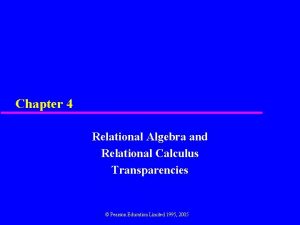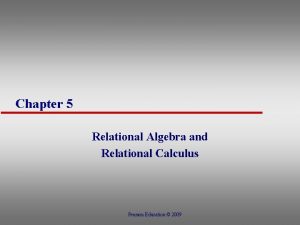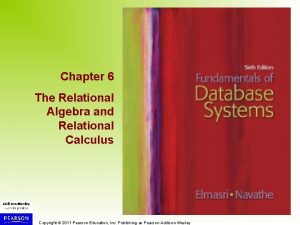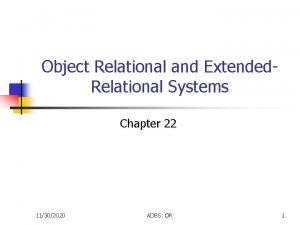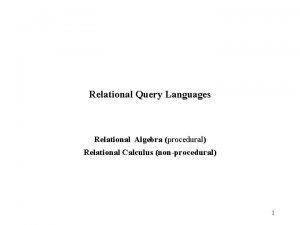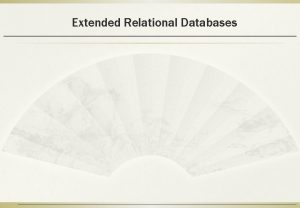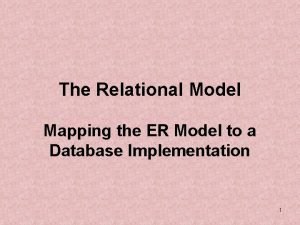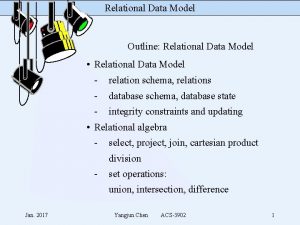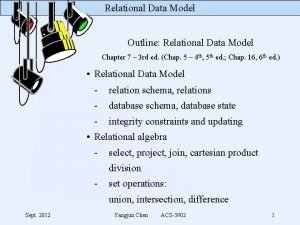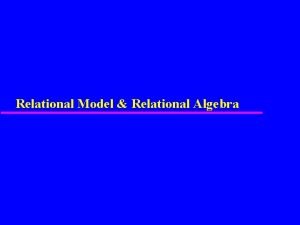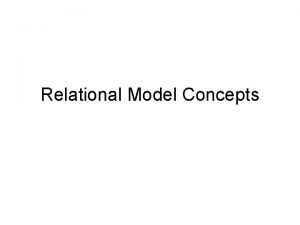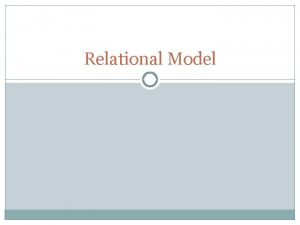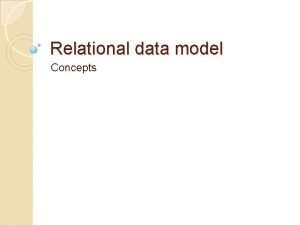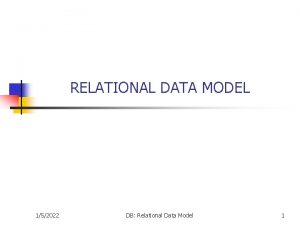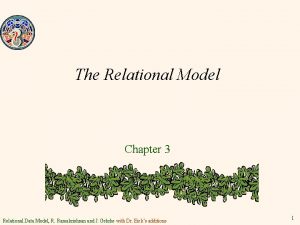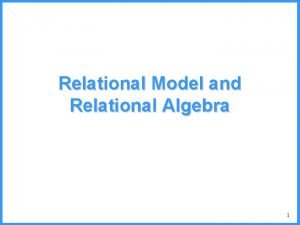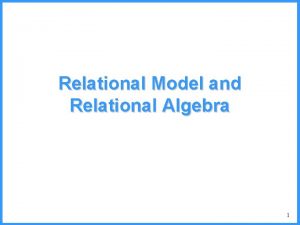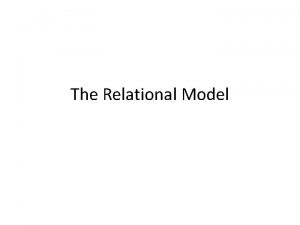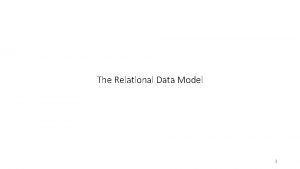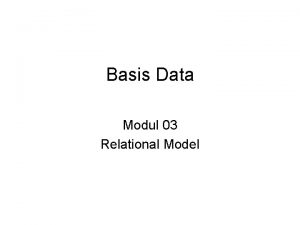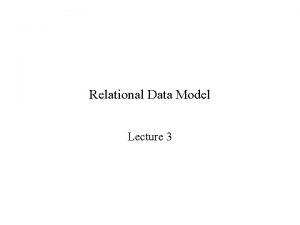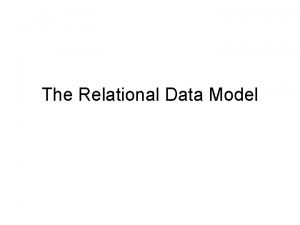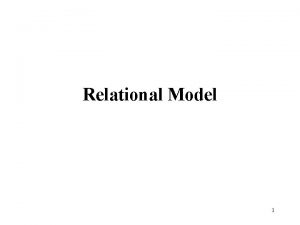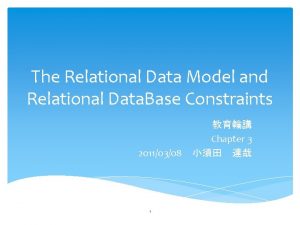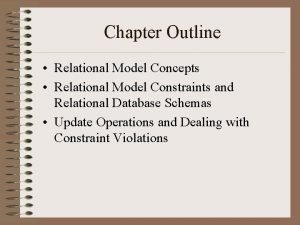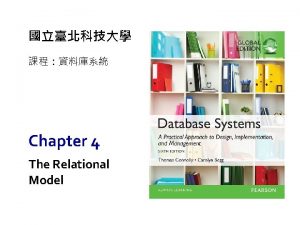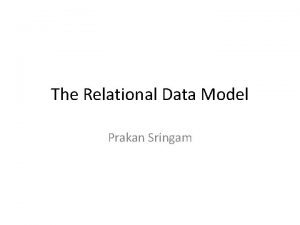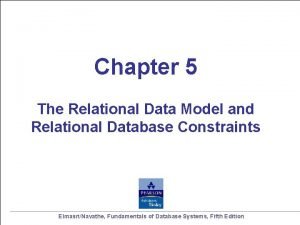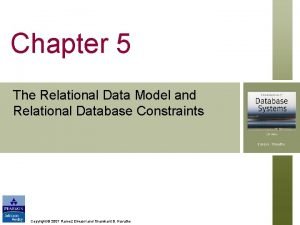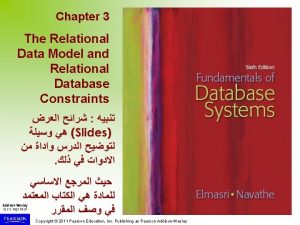CHAPTER 5 The Relational Data Model and Relational











































- Slides: 43

CHAPTER 5 The Relational Data Model and Relational Database Constraints Copyright © 2016 Ramez Elmasri and Shamkant B. Navathe Slide 1 - 1

Chapter Outline n n n Relational Model Concepts Relational Model Constraints and Relational Database Schemas Update Operations and Dealing with Constraint Violations Copyright © 2016 Ramez Elmasri and Shamkant B. Navathe Slide 5 - 2

Relational Model Concepts n n The relational Model of Data is based on the concept of a Relation The relational Model represents the database as a collection of relations Copyright © 2016 Ramez Elmasri and Shamkant B. Navathe Slide 5 - 3

Informal Definitions n Informally, a relation looks like a table of values. n A relation typically contains a set of rows. n n The data elements in each row represent certain facts that correspond to a real-world entity or relationship n In the formal model, rows are called tuples Each column has a column header that gives an indication of the meaning of the data items in that column n In the formal model, the column header is called an attribute name (or just attribute) Copyright © 2016 Ramez Elmasri and Shamkant B. Navathe Slide 5 - 4

Example of a Relation Copyright © 2016 Ramez Elmasri and Shamkant B. Navathe Slide 5 - 5

Informal Definitions n Key of a Relation: n Each row has a value of a data item (or set of items) that uniquely identifies that row in the table n n n Called the key In the STUDENT table, SSN is the key Sometimes row-ids or sequential numbers are assigned as keys to identify the rows in a table n Called artificial key or surrogate key Copyright © 2016 Ramez Elmasri and Shamkant B. Navathe Slide 5 - 6

Formal Definitions - Schema n The Schema (or description) of a Relation: n n Example: CUSTOMER (Cust-id, Cust-name, Address, Phone#) n n n Denoted by R(A 1, A 2, . . . An) R is the name of the relation The attributes of the relation are A 1, A 2, . . . , An CUSTOMER is the relation name Defined over the four attributes: Cust-id, Cust-name, Address, Phone# Each attribute has a domain or a set of valid values. n For example, the domain of Cust-id is 6 digit numbers. Copyright © 2016 Ramez Elmasri and Shamkant B. Navathe Slide 5 - 7

Formal Definitions - Tuple n n n A tuple is an ordered set of values (enclosed in angled brackets ‘< … >’) Each value is derived from an appropriate domain. A row in the CUSTOMER relation is a 4 -tuple and would consist of four values, for example: n n <632895, "John Smith", "101 Main St. Atlanta, GA 30332", "(404) 894 -2000"> This is called a 4 -tuple as it has 4 values A tuple (row) in the CUSTOMER relation. A relation is a set of such tuples (rows) Copyright © 2016 Ramez Elmasri and Shamkant B. Navathe Slide 5 - 8

Formal Definitions - Domain n A domain has a logical definition: n n A domain also has a data-type or a format defined for it. n n n Example: “USA_phone_numbers” are the set of 10 digit phone numbers valid in the U. S. The USA_phone_numbers may have a format: (ddd)ddd-dddd where each d is a decimal digit. Dates have various formats such as year, month, date formatted as yyyy-mm-dd, or as dd mm, yyyy etc. The attribute name designates the role played by a domain in a relation: n Used to interpret the meaning of the data elements corresponding to that attribute n Example: The domain Date may be used to define two attributes named “Invoice-date” and “Payment-date” with different meanings Copyright © 2016 Ramez Elmasri and Shamkant B. Navathe Slide 5 - 9

Formal Definitions - State n The relation state is a subset of the Cartesian product of the domains of its attributes n n Example: attribute Cust-name is defined over the domain of character strings of maximum length 25 n n each domain contains the set of all possible values the attribute can take. dom(Cust-name) is varchar(25) The role these strings play in the CUSTOMER relation is that of the name of a customer. Copyright © 2016 Ramez Elmasri and Shamkant B. Navathe Slide 5 - 10

Formal Definitions - Summary n Formally, n n n Given R(A 1, A 2, . . , An) r(R) dom (A 1) X dom (A 2) X. . X dom(An) R(A 1, A 2, …, An) is the schema of the relation R is the name of the relation A 1, A 2, …, An are the attributes of the relation r(R): a specific state (or "value" or “population”) of relation R – this is a set of tuples (rows) n n r(R) = {t 1, t 2, …, tn} where each ti is an n-tuple ti = <v 1, v 2, …, vn> where each vj element-of dom(Aj) Copyright © 2016 Ramez Elmasri and Shamkant B. Navathe Slide 5 - 11

Formal Definitions - Example n Let R(A 1, A 2) be a relation schema: n n n Let dom(A 1) = {0, 1} Let dom(A 2) = {a, b, c} Then: dom(A 1) X dom(A 2) is all possible combinations: {<0, a> , <0, b> , <0, c>, <1, a>, <1, b>, <1, c> } n n The relation state r(R) dom(A 1) X dom(A 2) For example: r(R) could be {<0, a> , <0, b> , <1, c> } n n this is one possible state (or “population” or “extension”) r of the relation R, defined over A 1 and A 2. It has three 2 -tuples: <0, a> , <0, b> , <1, c> Copyright © 2016 Ramez Elmasri and Shamkant B. Navathe Slide 5 - 12

Definition Summary Informal Terms Formal Terms Table Relation Column Header Attribute All possible Column Values Row Domain Table Definition Schema of a Relation Populated Table State of the Relation Copyright © 2016 Ramez Elmasri and Shamkant B. Navathe Tuple Slide 5 - 13

Example – A relation STUDENT Copyright © 2016 Ramez Elmasri and Shamkant B. Navathe Slide 5 - 14

Characteristics Of Relations n n Ordering of tuples in a relation r(R): n The tuples are not considered to be ordered, even though they appear to be in the tabular form. Ordering of attributes in a relation schema R (and of values within each tuple): n We will consider the attributes in R(A 1, A 2, . . . , An) and the values in t=<v 1, v 2, . . . , vn> to be ordered. n n n (However, a more general alternative definition of relation does not require this ordering. It includes both the name and the value for each of the attributes ). Example: t= { <name, “John” >, <SSN, 123456789> } This representation may be called as “self-describing”. Copyright © 2016 Ramez Elmasri and Shamkant B. Navathe Slide 5 - 15

Same state as previous Figure (but with different order of tuples) Copyright © 2016 Ramez Elmasri and Shamkant B. Navathe Slide 5 - 16

Characteristics Of Relations n Values in a tuple: n n All values are considered atomic (indivisible). Each value in a tuple must be from the domain of the attribute for that column n If tuple t = <v 1, v 2, …, vn> is a tuple (row) in the relation state r of R(A 1, A 2, …, An) Then each vi must be a value from dom(Ai) A special null value is used to represent values that are unknown or not available or inapplicable in certain tuples. Copyright © 2016 Ramez Elmasri and Shamkant B. Navathe Slide 5 - 17

Characteristics Of Relations n Notation: n We refer to component values of a tuple t by: n n n t[Ai] or t. Ai This is the value vi of attribute Ai for tuple t Similarly, t[Au, Av, . . . , Aw] refers to the subtuple of t containing the values of attributes Au, Av, . . . , Aw, respectively in t Copyright © 2016 Ramez Elmasri and Shamkant B. Navathe Slide 5 - 18

CONSTRAINTS Constraints determine which values are permissible and which are not in the database. They are of three main types: 1. Inherent or Implicit Constraints: These are based on the data model itself. (E. g. , relational model does not allow a list as a value for any attribute) 2. Schema-based or Explicit Constraints: They are expressed in the schema by using the facilities provided by the model. (E. g. , max. cardinality ratio constraint in the ER model) 3. Application based or semantic constraints: These are beyond the expressive power of the model and must be specified and enforced by the application programs. Slide 5 - 19 Copyright © 2016 Ramez Elmasri and Shamkant B. Navathe

Relational Integrity Constraints n n Constraints are conditions that must hold on all valid relation states. There are three main types of (explicit schema-based) constraints that can be expressed in the relational model: n n Key constraints Entity integrity constraints Referential integrity constraints Another schema-based constraint is the domain constraint n Every value in a tuple must be from the domain of its attribute (or it could be null, if allowed for that attribute) Copyright © 2016 Ramez Elmasri and Shamkant B. Navathe Slide 5 - 20

Key Constraints n Superkey of R: n Is a set of attributes SK of R with the following condition: n n Key of R: n n n No two tuples in any valid relation state r(R) will have the same value for SK That is, for any distinct tuples t 1 and t 2 in r(R), t 1[SK] t 2[SK] This condition must hold in any valid state r(R) A "minimal" superkey That is, a key is a superkey K such that removal of any attribute from K results in a set of attributes that is not a superkey (does not possess the superkey uniqueness property) A Key is a Superkey but not vice versa Copyright © 2016 Ramez Elmasri and Shamkant B. Navathe Slide 5 - 21

Key Constraints (continued) n Example: Consider the CAR relation schema: n n CAR(State, Reg#, Serial. No, Make, Model, Year) CAR has two keys: n n n Key 1 = {State, Reg#} Key 2 = {Serial. No} Both are also superkeys of CAR {Serial. No, Make} is a superkey but not a key. In general: n n n Any key is a superkey (but not vice versa) Any set of attributes that includes a key is a superkey A minimal superkey is also a key Copyright © 2016 Ramez Elmasri and Shamkant B. Navathe Slide 5 - 22

Key Constraints (continued) n If a relation has several candidate keys, one is chosen arbitrarily to be the primary key. n n Example: Consider the CAR relation schema: n n n CAR(State, Reg#, Serial. No, Make, Model, Year) We chose Serial. No as the primary key The primary key value is used to uniquely identify each tuple in a relation n n The primary key attributes are underlined. Provides the tuple identity Also used to reference the tuple from another tuple n n General rule: Choose as primary key the smallest of the candidate keys (in terms of size) Not always applicable – choice is sometimes subjective Copyright © 2016 Ramez Elmasri and Shamkant B. Navathe Slide 5 - 23

CAR table with two candidate keys – License. Number chosen as Primary Key Copyright © 2016 Ramez Elmasri and Shamkant B. Navathe Slide 5 - 24

Relational Database Schema n Relational Database Schema: n n n A set S of relation schemas that belong to the same database. S is the name of the whole database schema S = {R 1, R 2, . . . , Rn} and a set IC of integrity constraints. R 1, R 2, …, Rn are the names of the individual relation schemas within the database S Following slide shows a COMPANY database schema with 6 relation schemas Copyright © 2016 Ramez Elmasri and Shamkant B. Navathe Slide 5 - 25

COMPANY Database Schema Copyright © 2016 Ramez Elmasri and Shamkant B. Navathe Slide 5 - 26

Relational Database State n n A relational database state DB of S is a set of relation states DB = {r 1, r 2, . . . , rm} such that each ri is a state of Ri and such that the ri relation states satisfy the integrity constraints specified in IC. A relational database state is sometimes called a relational database snapshot or instance. We will not use the term instance since it also applies to single tuples. A database state that does not meet the constraints is an invalid state Copyright © 2016 Ramez Elmasri and Shamkant B. Navathe Slide 5 - 27

Populated database state n n Each relation will have many tuples in its current relation state The relational database state is a union of all the individual relation states Whenever the database is changed, a new state arises Basic operations for changing the database: n n INSERT a new tuple in a relation DELETE an existing tuple from a relation MODIFY an attribute of an existing tuple Next slide (Fig. 5. 6) shows an example state for the COMPANY database schema shown in Fig. 5. 5. Copyright © 2016 Ramez Elmasri and Shamkant B. Navathe Slide 5 - 28

Populated database state for COMPANY Copyright © 2016 Ramez Elmasri and Shamkant B. Navathe Slide 5 - 29

Entity Integrity n Entity Integrity: n The primary key attributes PK of each relation schema R in S cannot have null values in any tuple of r(R). n n This is because primary key values are used to identify the individual tuples. t[PK] null for any tuple t in r(R) If PK has several attributes, null is not allowed in any of these attributes Note: Other attributes of R may be constrained to disallow null values, even though they are not members of the primary key. Copyright © 2016 Ramez Elmasri and Shamkant B. Navathe Slide 5 - 30

Referential Integrity n A constraint involving two relations n n The previous constraints involve a single relation. Used to specify a relationship among tuples in two relations: n The referencing relation and the referenced relation. Copyright © 2016 Ramez Elmasri and Shamkant B. Navathe Slide 5 - 31

Referential Integrity n Tuples in the referencing relation R 1 have attributes FK (called foreign key attributes) that reference the primary key attributes PK of the referenced relation R 2. n n A tuple t 1 in R 1 is said to reference a tuple t 2 in R 2 if t 1[FK] = t 2[PK]. A referential integrity constraint can be displayed in a relational database schema as a directed arc from R 1. FK to R 2. Copyright © 2016 Ramez Elmasri and Shamkant B. Navathe Slide 5 - 32

Referential Integrity (or foreign key) Constraint n Statement of the constraint n The value in the foreign key column (or columns) FK of the referencing relation R 1 can be either: n n n (1) a value of an existing primary key value of a corresponding primary key PK in the referenced relation R 2, or (2) a null. In case (2), the FK in R 1 should not be a part of its own primary key. Copyright © 2016 Ramez Elmasri and Shamkant B. Navathe Slide 5 - 33

Displaying a relational database schema and its constraints n n Each relation schema can be displayed as a row of attribute names The name of the relation is written above the attribute names The primary key attribute (or attributes) will be underlined A foreign key (referential integrity) constraints is displayed as a directed arc (arrow) from the foreign key attributes to the referenced table n n Can also point the primary key of the referenced relation for clarity Next slide shows the COMPANY relational schema diagram with referential integrity constraints Copyright © 2016 Ramez Elmasri and Shamkant B. Navathe Slide 5 - 34

Referential Integrity Constraints for COMPANY database Copyright © 2016 Ramez Elmasri and Shamkant B. Navathe Slide 5 - 35

Other Types of Constraints n n Semantic Integrity Constraints: n based on application semantics and cannot be expressed by the model per se n Example: “the max. no. of hours per employee for all projects he or she works on is 56 hrs per week” A constraint specification language may have to be used to express these SQL-99 allows CREATE TRIGGER and CREATE ASSERTION to express some of these semantic constraints Keys, Permissibility of Null values, Candidate Keys (Unique in SQL), Foreign Keys, Referential Integrity etc. are expressed by the CREATE TABLE statement in SQL. Copyright © 2016 Ramez Elmasri and Shamkant B. Navathe Slide 5 - 36

Update Operations on Relations n n n INSERT a tuple. DELETE a tuple. MODIFY a tuple. Integrity constraints should not be violated by the update operations. Several update operations may have to be grouped together. Updates may propagate to cause other updates automatically. This may be necessary to maintain integrity constraints. Copyright © 2016 Ramez Elmasri and Shamkant B. Navathe Slide 5 - 37

Update Operations on Relations n In case of integrity violation, several actions can be taken: n n Cancel the operation that causes the violation (RESTRICT or REJECT option) Perform the operation but inform the user of the violation Trigger additional updates so the violation is corrected (CASCADE option, SET NULL option) Execute a user-specified error-correction routine Copyright © 2016 Ramez Elmasri and Shamkant B. Navathe Slide 5 - 38

Possible violations for each operation n INSERT may violate any of the constraints: n Domain constraint: n n Key constraint: n n if the value of a key attribute in the new tuple already exists in another tuple in the relation Referential integrity: n n if one of the attribute values provided for the new tuple is not of the specified attribute domain if a foreign key value in the new tuple references a primary key value that does not exist in the referenced relation Entity integrity: n if the primary key value is null in the new tuple Copyright © 2016 Ramez Elmasri and Shamkant B. Navathe Slide 5 - 39

Possible violations for each operation n DELETE may violate only referential integrity: n If the primary key value of the tuple being deleted is referenced from other tuples in the database n Can be remedied by several actions: RESTRICT, CASCADE, SET NULL (see Chapter 6 for more details) n n RESTRICT option: reject the deletion CASCADE option: propagate the new primary key value into the foreign keys of the referencing tuples SET NULL option: set the foreign keys of the referencing tuples to NULL One of the above options must be specified during database design for each foreign key constraint Copyright © 2016 Ramez Elmasri and Shamkant B. Navathe Slide 5 - 40

Possible violations for each operation n n UPDATE may violate domain constraint and NOT NULL constraint on an attribute being modified Any of the other constraints may also be violated, depending on the attribute being updated: n Updating the primary key (PK): n n n Updating a foreign key (FK): n n Similar to a DELETE followed by an INSERT Need to specify similar options to DELETE May violate referential integrity Updating an ordinary attribute (neither PK nor FK): n Can only violate domain constraints Copyright © 2016 Ramez Elmasri and Shamkant B. Navathe Slide 5 - 41

Summary n Presented Relational Model Concepts n n n Discussed Relational Model Constraints and Relational Database Schemas n n n Definitions Characteristics of relations Domain constraints Key constraints Entity integrity Referential integrity Described the Relational Update Operations and Dealing with Constraint Violations Copyright © 2016 Ramez Elmasri and Shamkant B. Navathe Slide 5 - 42

In-Class Exercise (Taken from Exercise 5. 15) Consider the following relations for a database that keeps track of student enrollment in courses and the books adopted for each course: STUDENT(SSN, Name, Major, Bdate) COURSE(Course#, Cname, Dept) ENROLL(SSN, Course#, Quarter, Grade) BOOK_ADOPTION(Course#, Quarter, Book_ISBN) TEXT(Book_ISBN, Book_Title, Publisher, Author) Draw a relational schema diagram specifying the foreign keys for this schema. (We will do this in Chapter 9) Copyright © 2016 Ramez Elmasri and Shamkant B. Navathe Slide 5 - 43
 The limited tuple relational calculus equals:
The limited tuple relational calculus equals: Relational algebra and relational calculus
Relational algebra and relational calculus Relational calculus symbols
Relational calculus symbols Object relational and extended relational databases
Object relational and extended relational databases Relational algebra and relational calculus
Relational algebra and relational calculus Logical view of database
Logical view of database Extended relational data model
Extended relational data model Mapping of er model to relational model
Mapping of er model to relational model Hình ảnh bộ gõ cơ thể búng tay
Hình ảnh bộ gõ cơ thể búng tay Lp html
Lp html Bổ thể
Bổ thể Tỉ lệ cơ thể trẻ em
Tỉ lệ cơ thể trẻ em Gấu đi như thế nào
Gấu đi như thế nào Tư thế worms-breton
Tư thế worms-breton Hát lên người ơi
Hát lên người ơi Môn thể thao bắt đầu bằng từ đua
Môn thể thao bắt đầu bằng từ đua Thế nào là hệ số cao nhất
Thế nào là hệ số cao nhất Các châu lục và đại dương trên thế giới
Các châu lục và đại dương trên thế giới Công thức tiính động năng
Công thức tiính động năng Trời xanh đây là của chúng ta thể thơ
Trời xanh đây là của chúng ta thể thơ Mật thư anh em như thể tay chân
Mật thư anh em như thể tay chân Phép trừ bù
Phép trừ bù Phản ứng thế ankan
Phản ứng thế ankan Các châu lục và đại dương trên thế giới
Các châu lục và đại dương trên thế giới Thơ thất ngôn tứ tuyệt đường luật
Thơ thất ngôn tứ tuyệt đường luật Quá trình desamine hóa có thể tạo ra
Quá trình desamine hóa có thể tạo ra Một số thể thơ truyền thống
Một số thể thơ truyền thống Cái miệng bé xinh thế chỉ nói điều hay thôi
Cái miệng bé xinh thế chỉ nói điều hay thôi Vẽ hình chiếu vuông góc của vật thể sau
Vẽ hình chiếu vuông góc của vật thể sau Biện pháp chống mỏi cơ
Biện pháp chống mỏi cơ đặc điểm cơ thể của người tối cổ
đặc điểm cơ thể của người tối cổ Ví dụ về giọng cùng tên
Ví dụ về giọng cùng tên Vẽ hình chiếu đứng bằng cạnh của vật thể
Vẽ hình chiếu đứng bằng cạnh của vật thể Tia chieu sa te
Tia chieu sa te Thẻ vin
Thẻ vin đại từ thay thế
đại từ thay thế điện thế nghỉ
điện thế nghỉ Tư thế ngồi viết
Tư thế ngồi viết Diễn thế sinh thái là
Diễn thế sinh thái là Dot
Dot Số nguyên tố là gì
Số nguyên tố là gì Tư thế ngồi viết
Tư thế ngồi viết Lời thề hippocrates
Lời thề hippocrates Thiếu nhi thế giới liên hoan
Thiếu nhi thế giới liên hoan
